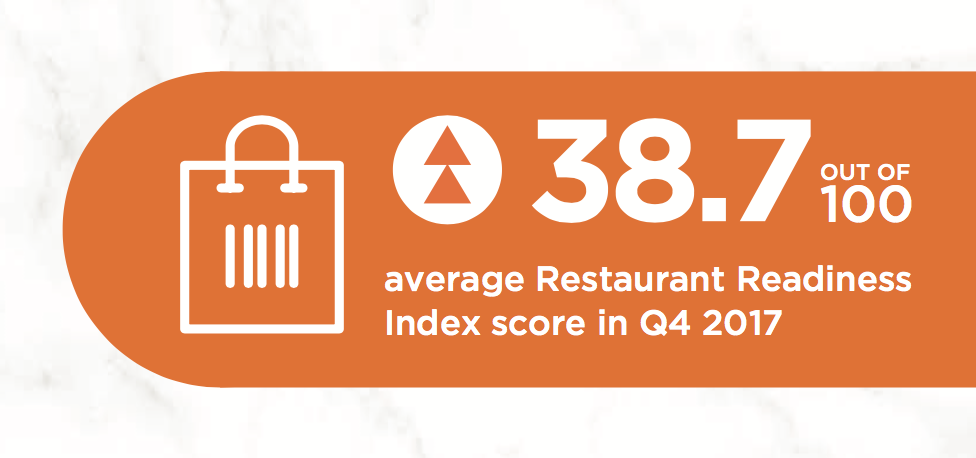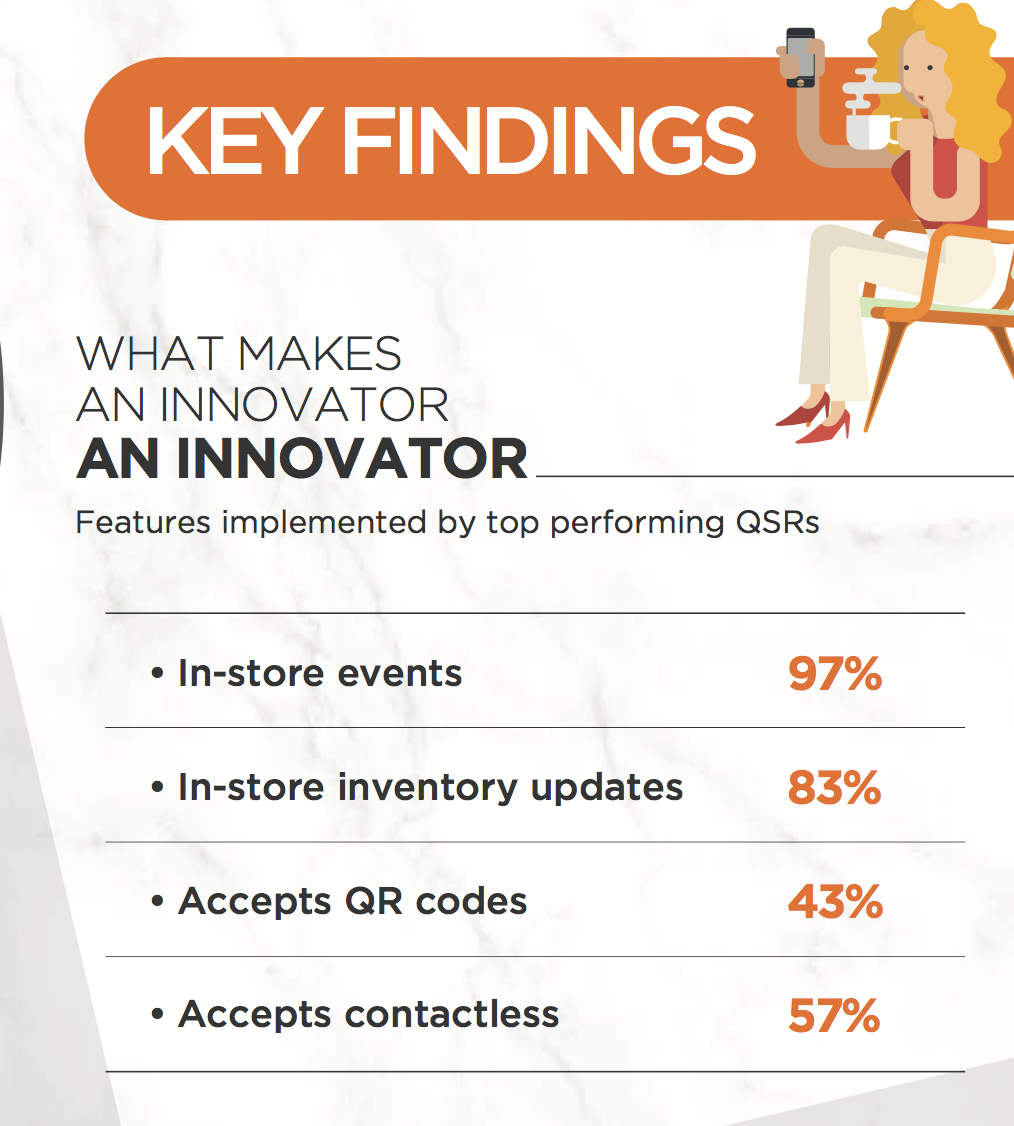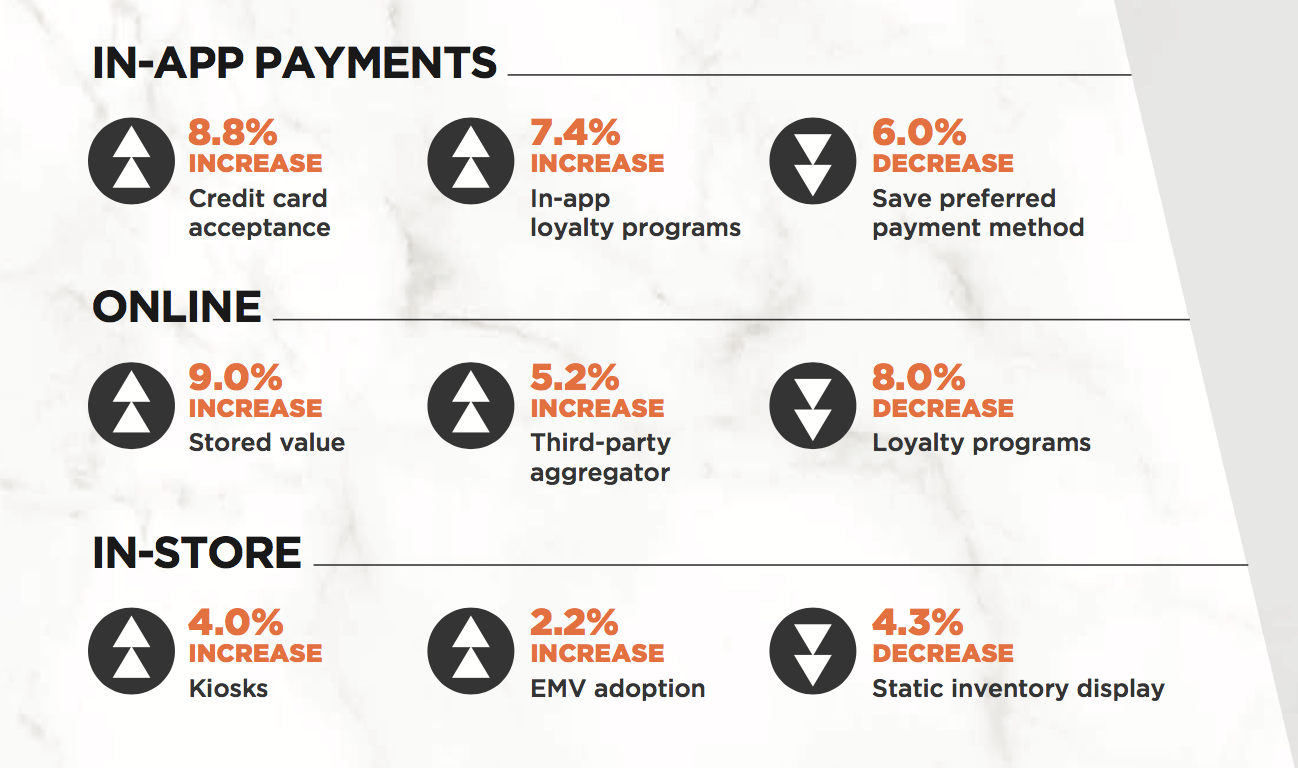
Quick Serve Restaurants have mastered making food and drinks, but they are nowhere close to mastering how customers want to be served these days. The latest Restaurant Readiness Index survey shows QSRs should be focusing on digital services to boost the customer experience — and with it, sales. The latest Index, covering the first quarter of 2018, examined what the best innovators are doing and found it’s not enough to be just diving into digital — though that’s a start, given the generally poor state of QSR innovation. It’s how you’re going into digital that matters, too.
The Restaurant Readiness Index is an analysis of 178 QSRs and more than 100 features available in the restaurants, online and through mobile apps. Each restaurant is then graded from 0 to 100, representing no innovation at all to most innovative. In the latest quarter, the QSR industry as a whole scored just 38.7.

Granted, that’s a slight increase of 0.7 from last quarter, but indicative that the industry has a lot of room to advance. PYMNTS compiles the Restaurant Readiness Index in collaboration with Bypass and Bank of America Merchant Services. The index debuted for the fourth quarter of 2017 and found that while customers are clamoring for digital innovation in-store and out-of-store, QSRs by and large aren’t giving it to them. The research further finds that even while some restaurants are making strides at becoming more innovative, too many are focusing on the wrong improvements rather than the ones that really move the needle for consumers, according to the finding of the PYMNTS study.
So what makes an innovative restaurant? There are four services that show up again and again for top-performing QSRs. Nearly every one, 97 percent of the top-performing restaurants, offer in-store events. Looking at QSRs as a whole, that percentage falls to 73 percent, up one percentage point from last quarter. The best QSRs — 83 percent in the Restaurant Readiness Index — also offer in-store inventory updates, yet there was a sharp decrease in that metric for the industry overall this quarter, dropping five percentage points to 67 percent, according to the analysis.

QR code acceptance is still relatively small in the industry, with just 18 percent of QSRs capable of using them, an increase of two percentage points from last quarter. Meanwhile, upwards of half — some 43 percent — of the most innovative restaurants in the study accept QR codes. As far as payments, some 57 percent of the innovators accept contactless — transactions where a customer interacts with a specific terminal to pay — compared to just 35 percent of their peers, according to the study.
Interestingly, the industry seems to be taking a one step forward, one step back approach to boosting its digital innovation. While almost nine percent of QSRs added credit card acceptance as part of their in-app experience in the quarter, six percent dropped the ability to save a preferred payment method. In-store, there was a four percent rise in kiosks, which helps boost the convenience factor customers value, but a 4.3 percent drop in inventory display. Online, there was a nine percent rise in stored value features, while loyalty programs fell eight percent. That’s a surprising result, given the success organizations like Starbucks have had with loyalty programs. The coffee and treat retailer had 13.3 million members enrolled in its loyalty program as of mid-2017, according to the Index.

Perhaps no feature separates the innovators from the pack more than mobile apps. Not even half of QSRs have apps that have any functionality identified in the Restaurant Readiness Index survey. The most popular feature is the ability to order and pick up in store, something 45 percent of QSRs examined have, a level that actually slipped two percentage points from last quarter’s report. Among the QSRs rated in the top 20 percent of performers, 84 percent offer in-store pick-up. Just four percent of the bottom fifth of performers do.
“When you think about this digital evolution, it really all comes back to the idea of removing friction,” IHOP executive director and head of IT Michael Chachula told PYMNTS in a recent interview. “It’s about making things more convenient, and using mobile technology, the Internet of Things or whatever comes next to provide a fully immersive experience for guests.”
Among the more innovative QSRs, IHOP debuted its first mobile app in late 2017, which it uses not only to take customer orders, of course, but also to push notification promotional offers as incentive for customers to keep the app on their phone and become established users.
QSR innovation also varies by type of store. Soup, salad and bowl purveyors are the top performing category in the Index, presumably as part of the competition for lunch time office customers, a cohort particularly interested in speed and convenience. About 92 percent of these types of QSRs offer cloud-based features, with 88 percent offering in-store pick up via a mobile app. Half offer in-store order authentication. By contrast, frozen dessert restaurants are the worst category for digital innovation, with just 10 percent offering in-store pick-up from an app.
Interestingly, chain size doesn’t show much firm correlation with innovation, though chains with 26 to 50 locations did score best, at 44 of 100. The 178 QSRs the Restaurant Readiness Index examined ranged in size from eight to 2,640 locations across 10 segments, Asian to specialty (pizza was excluded). A full copy of the survey is available with PYMNTS indexes.